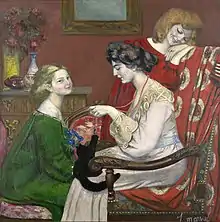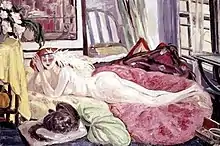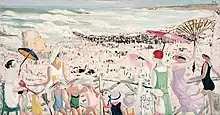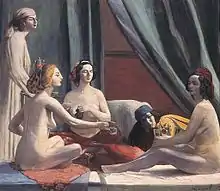Jacqueline Marval
Jacqueline Marval was the pseudonym for Marie Josephine Vallet (19 October 1866 – 28 May 1932), who was a French painter, lithographer and sculptor.[1]
Jacqueline Marval | |
|---|---|
 Self-portrait | |
| Born | Marie Josephine Vallet 19 October 1866 Quaix-en-Chartreuse, France |
| Died | 1932 Paris, France |
| Nationality | French |
| Known for | Painting |
| Spouse | Albert Valentin (m. 1886 - d. 1891) |
| Partner(s) | François Joseph Girot, Jules Flandrin |
Early life
Vallet was born in Quaix-en-Chartreuse into a family of school teachers.[2] She was married in 1866, to a traveling salesperson, Albert Valentin, but separated from her husband in 1891 after the death of her son.[1] She later made a living as a seamstress. It was in 1900 when Vallet took on the pseudonym Jacqueline Marval, "Marval" being the composite of her first and last name "MARie VALlet."[3]
Career as an artist




In 1894, Marval met the painter François Joseph Girot and began living with him in Paris, where she was introduced to Les Nabis group.[5] Girot introduced her to Jules Flandrin, another painter and a student of Gustave Moreau. The two fell in love, and Marval left Girot to move in with Flandrin in Rue Campagne-Première, in the Montparnasse area. She would live with him as his companion for 20 years.[6] As an artist, Marval worked primarily as a painter; however, she also made "lithographs, watercolours, pastels, engravings, tapestry designs and experimented with sculpture."[5]
Vallet's first works were rejected from the 1900 Salon des Indépendants, but she succeeded in having a dozen paintings shown in that exhibition the following year, in 1901. The works rejected in 1900 were bought by the art dealer Ambroise Vollard, who continued to support her work.[1]
Between 1901 and 1905, Marval worked frequently alongside Henri Matisse, Albert Marquet, and Flandrin, and the four influenced each other.[7]
In 1902, several of her paintings were displayed alongside works by Flandrin, Albert Marquet, and Henri Matisse in a gallery in Rue Victor-Massé curated by Berthe Weill, who was particularly interested in promoting the works of female artists living in Paris.[1] Marval also exhibited in the first Salon d'Automne, in 1902, where she showed her large scale painting Les Odalisques.[1]
In 1913, Marval was chosen by a jury made up of Gabriel Astruc, the sculptor Antoine Bourdelle, and the painters Maurice Denis and Édouard Vuillard to decorate the foyer of the new Théâtre des Champs-Élysées. She created a series of twelve paintings on the theme of Daphnis and Chloe.[8] The series was based on the Ballets Russes' production of Daphnis et Chloë , performed the year prior.[9]
Also in 1913, Marval protested against the removal from the Salon d'Automne of Kees van Dongen's The Spanish Shawl, and became friends with Van Dongen, setting up her studio near his. Marval and Flandrin moved into 40 rue Denfert Rochereau, which was next door to Van Dongen in 1914.[1] She attended his famous costumed ball in 1914.[1]
Marval's works began to be recognized across Europe and beyond; she exhibited in Barcelona, Liège, Venice, Zurich, Budapest, and Kyoto.[5]
Beginning in 1923, Marval was active in favor of the creation of modern art museums in Paris and Grenoble. She died at the Hôpital Bichât in Paris in 1932.[1] After her death, her works were held in the Galerie Druet before it was closed in 1938 and they were sold. Her painting Portrait of Dolly Davis, 1925 is in the collection of the Milwaukee Art Museum.[10]
Stylistically, "Marval's paintings are provocative and edgy, challenging and unusual, she was an important modernist at the earliest moments of the movement."[11]
Les Odalisques, 1902-03

Perhaps her most famous work, Les Odalisques, was made in 1902-03 and was first exhibited at the Salon des Indépendants in 1903. This painting depicts five women: three seated nude, one dressed and reclining on her elbow, and one standing, clothed and holding a tray. Les odalisques follows in the art historical tradition of large-scale orientalized bathing scenes, with a strong focus on the nude body and interaction between figures.
Guillaume Apollinaire was struck by this work, and wrote in Chronique des arts in 1912 that "Mme. Marval has given the measure of her talent and has achieved a work of importance for modern painting. This strong and sensual work, freely painted and wholly personal in composition, line, and coloring, deserves to survive."[12]
Les Odalisques now resides within the collection of the Musée de Grenoble and was last exhibited at the Musée Paul-Dini in 2018.[13]
Les Odalisques was not included in the historic 1913 Armory Show, as is frequently noted in literature on the artist. Instead, a different work by Marval, Odalisques au miroir, 1911, was shown at the Armory Show, after an invitation by Vollard.[14][15] Marval exhibited in the United States a number of additional times after the Armory Show.[3]
Critical reception and legacy
Critics gave Marval high praise during her career. In a 1911 issue of The Burlington Magazine for Connoisseurs, for example, it was written that at an exhibition at the Druet Gallery, "The paintings of Madame Marval were among the most striking..."[16] Apollinaire, aside from his compliments to Les Odalisques, more generally makes comments on her work that refer to it as exciting, strong, and worthy of recognition.[12] Some critics referred to her as a Fauve, a reflection of her choice of palette, which was heavily influenced by Fauve and Impressionist painters who came before her.[5] According to Lucien Manissieux, a student of Flandrin, "Marquet, Flandrin, Matisse all awaited each work she produced with curiosity and emotion" and there is some evidence that her male peers borrowed from her "brilliant colour and formal economy of her painting."[7]
During her lifetime, Marval refused to exhibit in all-female exhibitions; yet, after her death, her career and work was celebrated in one.[17] The Société des Femmes Artistes Modernes (FAM) was a women artists' collective in Paris. FAM was headed by Marie-Anne Camax-Zoegger (1887-1952), "a bourgeois French Catholic woman."[2] They put on a retrospective of Marval's work in 1933 as part of their annual exhibition.[2] Marval, who did not identify as a feminist, was appropriated by FAM as one and has since been celebrated as living a feminist life. Since her work was figural in nature, it fit well within the focus of FAM, which aimed to "organize annual exhibitions that featured the work of female artists from different countries and stylistic movements'."
Since her death, Marval's work has been exhibited many times, most often in France. A full list of exhibitions has been compiled on the website jacqueline-marval.com Archived 29 April 2021 at the Wayback Machine. In 2020-21, she was included in the exhibition Valadon et ses contemporaines at the Musée des beaux-arts de limoges, which was also on view at the Monstaère Royal de Brou from 13 March 2021 – 27 June 2021.[13]
References
- Perry, Gillian (1995). Women artists and the Parisian avant-garde: modernism and feminine art, 1900 to the late 1920s. Manchester [England]: Manchester University Press. ISBN 0-7190-4164-3. OCLC 31520024.
- Birnbaum, Paula (2011). Women artists in interwar France: framing femininities. Farnham, Surrey, UK, England: Ashgate. ISBN 978-0-7546-6978-4. OCLC 672300111.
- "Biography". Jacqueline Marval. Retrieved 24 March 2021.
- "Œuvres". Jacqueline Marval. Retrieved 24 March 2021.
- "Marval, Jacqueline", Benezit Dictionary of Artists, Oxford University Press, 31 October 2011, doi:10.1093/benz/9780199773787.article.b00118008, retrieved 24 March 2021
- Petteys, Chris, '’Dictionary of Women Artists'’, G K Hill & Co. publishers, 1985
- Beechey, James (2001). "Jules Flandrin. Oxford". The Burlington Magazine. 143 (1180): 440–441. ISSN 0007-6287. JSTOR 889111.
- Roussier, François (2008). Jacqueline Marval 1866-1932. Thalia édition. pp. 140–141. ISBN 978-2-35278-040-3. OCLC 758447941.
- Bellow, Juliet (2012). Modernism on stage : the Ballets Russes and the Parisian avant-garde. Farnham, Surrey. ISBN 978-1-4094-0911-3. OCLC 855360857.
{{cite book}}: CS1 maint: location missing publisher (link) - "Portrait of Dolly Davis | Milwaukee Art Museum". collection.mam.org. Retrieved 24 March 2021.
- "Jacqueline Marval". www.papillongallery.com. Retrieved 9 June 2020.
- Apollinaire, Guillaume; Breunig, LeRoy C. (9 June 1972). Apollinaire on art: essays and reviews, 1902-1918. Viking Press. ISBN 9780670019199. Retrieved 9 June 2020 – via Google Books.
- "Exhibitions". Jacqueline Marval. Archived from the original on 29 April 2021. Retrieved 24 March 2021.
- "Armory Show 1913 Complete List". The Armory Show at 100. Retrieved 24 March 2021.
- Brown, Milton W., '’The Story of the Armory Show'’, The Joseph H. Hirshhorn Foundation, 1963, p. 242
- D., R. E. (1911). "Art in France". The Burlington Magazine for Connoisseurs. 19 (97): 61–62. ISSN 0951-0788. JSTOR 858653.
- Birnbaum, Paula (2011). Women artists in interwar France : framing femininities. Farnham, Surrey, UK, England: Ashgate. ISBN 978-0-7546-6978-4. OCLC 672300111.
- Catherine Gonnard et Élisabeth Lebovici, Femmes / Artistes, artistes femme. Paris, de 1880 à nos jours, Éditions Hazan, Paris, 2007, pages 67 et 68
- François Roussier, Jacqueline Marval, 1866–1932, Thalia Édition, Paris, 2008
- Maurice Wantellet, Le Dauphiné et les peintres, une source d'inspiration, éditions Le Dauphiné libéré
- Maurice Wantellet, Deux siècles et plus de peinture dauphinoise, Grenoble, édité par l'auteur, 1987, 269 p. (ISBN 978-2-9502223-0-5)
External links
- "THE LIFE OF A GREAT ARTIST" This article was written by Andry-Farcy (1882–1949)
- Official website